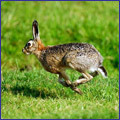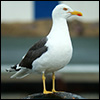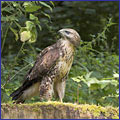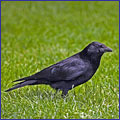Poisoning in wildlife

Lepus europaeus
(Photo, P. Munsterman, Saxifraga)
In 2011 five wildlife carcasses (a female hare, male crow, male lesser-black-backed gull, and juvenile male and female buzzards) found within 300m of each other were submitted to the DWHC for post-mortem investigation.
Macroscopic findings
The hare carcass was incomplete (internal organs excluding the uterus were missing) and in an advanced state of decomposition; large incision wounds were present in the groin and shoulder areas and these were covered with black grainy material.
All of the bird cadavers had a good nutritional condition and no external wounds were observed. An enlarged spleen and stomach contents consisting of hair and black grainy material were found in all of these birds. Additional findings included fluid on the lungs of the crow and liver and kidney pallor; both the seagull and the male buzzard had bloody (congestion) lungs and bleeding in the brain, possibly as a result of shock; the liver of the female buzzard was slightly enlarged.

Larus fuscus
(Photo, J. van der Straaten, Saxifraga)
Microscopic findings
Examination of tissue under the microscope was limited by artifacts in the tissues due to decomposition or freezing. The few organs that were investigated from the hare were microscopically normal. Small numbers of granulomatous inflammatory lesions were found in the livers of the crow and both buzzards and also in the lungs of the male buzzard.The male buzzard had locally thickend skin; the lungs and spleen of the female buzzard were bloody and the lungs of the seagull contained dust (anthracosis).

Buteo buteo
(Photo, M. Mollet, Saxifraga)
Toxicologic analysis
Toxicologic analysis of the black grainy material found in the wounds of the hare and the stomach of the male buzzard was performed at the Gezondheidsdienst voor Dieren (Animal Health Institute) in Deventer. In both cases carbamates (Aldicarb) was detected. The concentration in the stomach was notably high at 830 mg/kg body weight.
Conclusion
With the exception of the brain bleeds, suggestive of acute shock, the abnormalities found in the bird carcasses were insufficient to explain the deaths of these birds. However, the concentration of carbamate found in the stomach of the buzzard could have been lethal, leading to shock and death. Given the similar appearance of the stomach contents of the other birds it is believed that carbamate intoxication was the cause of death in all of the birds and that the hare carcass was used as bait.
Aldicarb intoxication

Corvus corone
(Photo, M. Zekhuis, Saxifraga)
Aldicarb is a carbamate-based insecticide used to kill invertebrates; it is very toxic to mammals and birds in which consumption can lead to paralysis of the respiratory system leading to respiratory failure and death [2, 3].
Lethal dose 50% (LD50, the amount of substance required to kill 50% of a population) is used as a measure of toxicity of a substance. The LD50 of Aldicarb in mammals in solution or suspension is 0,5 mg/kg body weight [4]. The toxicity of dry granules is lower with a LD50 of 7 mg/kg [1].
Aldicarb is used in agriculture to protect crops from pests [5]. The use of carbamate-based products has been banned in the Netherlands since 2007 due to the pollution of groundwater.
However, despite this ban, Aldicarb is still used by some to poison nuisance wild animals such as foxes and birds of prey. In addition to being illegal, such usage constitutes animal abuse.
References
- 1996. Aldicarb. Pesticide Information Profiles. The Extension Toxicology Network. Lees meer…
- Grue C.E. Gibert P.L. and Seeley M.E. 1997. Neurophysiological and behavioral changes in non-target wildlife exposed to organophosphate and carbamate pesticides: thermoregulation, food consumption, and reproduction. American Zoologist, 37: 369–388. Lees meer…
- Hill E.F. and Camardese M.B. 1984. Toxicity of anticholinesterase insecticides to birds: technical grade versus granular formulations. Ecotoxicology and Environmental Safety, 8: 551–563.
- Risher J.F. Mink F.L. and Stara J.F. 1987.The toxicologic effects of the carbamate insecticide aldicarb in mammals: a review. Environmental Health Perspectives, 72: 267–281.
- WHO 2003. Aldicarb in Drinking-water. Lees meer…



